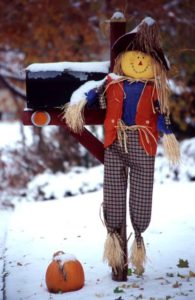Freezing temps along the Front Range this week mark the end of Colorado’s  growing season. Time has come to wrap things up and tuck the yard in for its long winter’s nap.
growing season. Time has come to wrap things up and tuck the yard in for its long winter’s nap.
Here are some tips for harvesting veggies post-freeze and chores that could be finished during the warm weekend ahead.
Post-freeze harvest
- Carrots, parsnips and turnips can be left in the ground for harvesting later.
- Un-ripened tomatoes should have been brought inside before frost. If you need to speed up ripening the green ones, put them in a paper bag with an apple.
- Squashes, melons and pumpkins will likely have been damaged by the freeze. Still, you can take them off the vines to enjoy for a while depending on the damage. Leave as much stem on them as you can and avoid picking them up and carrying them by the stem as that can break the stem and further hasten decline of the vegetable. The warmth indoors will speed ripening and help green pumpkins turn orange.
Flowers and herbs
- For outdoor fall color, rely on cool season plants – pansies, violas and kale.
- Annual herbs can grow indoors in containers as long as they have not been damaged by frost or freeze. Good herbs to grow indoors include sage, basil, parsley, stevia and tea.
- Hardy herbs, such as chives, mint and oregano, can be left in the ground as they should come back next spring.
Fall clean-up and composting
One warm weekend is probably all you need to get your season-closer chores checked off the list. Here are a few reminders about what plant material to remove, what can be left and some tips for keeping growing spaces healthy for next year’s projects.
- Remove all annual veggies, herbs and flowers once they have been freeze damaged.
- Perennials: spring-flowering perennials can be divided in the fall. Foliage on other perennials, such as daisies, can be cut back.
- Leave some plants in the yard to provide winter food for birds and other wildlife. Great plants to leave standing include sunflowers, Echinacea and ornamental grasses.
- Remove and dispose of all dead fruit and veggies that are on the ground.
- When cleaning up garden debris, know which plants are best to pitch in the compost pile-and which ones are not.
- Do compost: leaves, grass clippings, straw, non-diseased plant debris and weeds if they have not gone to seed.
- Avoid composting: any plants which are diseased and large pumpkin and squash vines because they take too long to decompose. Because tomato plants often carry diseases, some gardeners avoid composting them altogether.
- Finally, add mulch over the garden to maintain moisture and soil quality. Add straw, a fresh layer of compost or use grass clippings from the final lawn mowing.
With unsightly debris removed and a blanket of mulch, your garden will be nicely tucked in for the winter. Now you’re ready to take a time-out from landscape chores!
